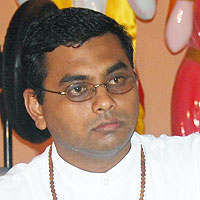From a satsang with Pt. Umadutt Maharaj, Spiritual Leader, SWAHA Bhakti Jyot Mandali
In the vast collection of Hindu scriptures, the Mahabharata stands as a monumental saga, its threads woven with the very essence of existence. At its inception lies the sacred syllable ‘Omkar’, the primal resonance that reverberates through the cosmos and ushers in the profound narrative. This divine syllable, chanted at the beginning of all mantras, symbolises the primal sound from which creation springs, a reminder that the entire universe is a manifestation of divine energy.
At the heart of this cosmic tale stands Ved Vyasji, the ancient sage who chiselled the Mahabharata into existence. This act of transcendental creation sets the stage for the cosmic dance of the Mahabharata. The momentous task of transcribing the grand epic, however, did not come without conditions. The celestial scribe, Lord Ganesh, joined Vyasji in this extraordinary endeavour. Ganeshji, known for his wit and wisdom, laid down his terms – that He must be able to write continuously. In return, Vyasji presented his condition – that Ganeshji must comprehend the essence of each verse before transcribing it. Thus, an extraordinary pact was forged, birthing the sacred partnership of creation and comprehension. Ganeshji was the universe’s first scribe, underscoring the significance of reflection in the process of creation.
Within the sprawling narrative of the Mahabharata lies an eternal gem, the Bhagavad Gita, the spiritual discourse that encapsulates the essence of existence. The cosmic charioteer, Shree Krishna, imparts profound wisdom to the warrior Arjuna, poised in the midst of an existential crisis. This discourse forms the crown jewel of the Mahabharata, a celestial melody that resonates through time.
Shree Krishna’s guidance on duty, righteousness and devotion unveils the profound essence of life. The battlefield becomes a metaphor for the internal struggles we all face, where our own desires and dilemmas confront us. Arjuna, standing at the crossroads, mirrors the choices we must make in our journey. In this cosmic symphony, Shree Ganesha assumes the role of the first student, imbibing the teachings of the Gita as they are expounded.
Within each of us resides the spirit of Ved Vyasji, the essence of all rivers, sages and deities. The Mahabharata’s tapestry is not confined to the pages of a book; it weaves through our very souls, reminding us of our connection to the divine. The pulsating rhythms of the Mahabharata are the echoes of our own hearts, resonating with the eternal dance of life.
In the realm of observances, occasions like Shree Krishna Jayanti and Ganesh Utsav stand as naimittik karma, sacred acts that invoke blessings and elevate our spirits. Through these rituals, we bridge the gap between the material and spiritual worlds, nurturing a profound connection with the divine.
The Mahabharata’s external battles mirror the internal conflicts that we grapple with each day – the eternal struggle between light and darkness, good and evil. The Pandavas, led by the divine guidance of Krishna, conquered thousands, reminding us that with divine grace, even the most formidable challenges can be surmounted.
We are the jeevatma, individual souls, vessels of immense potential. The Paramatma, the universal soul, resides within us, ready to be unveiled once we journey within. The Mahabharata’s ultimate moral resounds through the annals of time – when we assume the mantle of responsibility for our lives, when we become the charioteers of our destinies, the forces of righteousness and goodness triumph over negativity.
The essence of the Mahabharata continues to illuminate our lives. Within its verses, the celestial dance of creation, comprehension, introspection and transformation intertwines, guiding us on a path of self-discovery and divine realisation. Like Ganeshji, may we all embrace the mantle of students, learning from its wisdom, and journey within to awaken the dormant divinity that resides in each of us.



